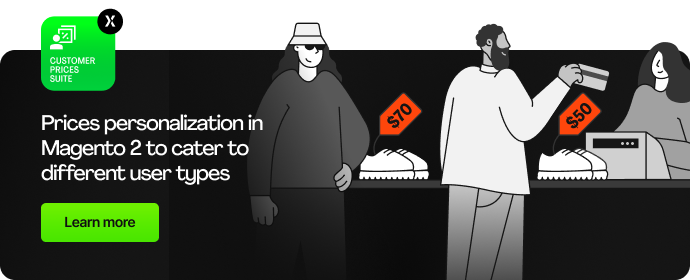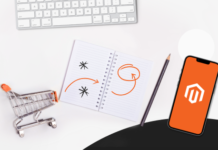Without user testing, marketers can’t determine what the market and customers need. Employing user testing methods helps you make the right decision.
Table of Contents
Usability Testing, A/B Testing, and More: User Testing Techniques
Marketing is a competitive field. You must cater to the needs of your customers to draw them in, and that’s exactly why you need usability testing. It’s always a good idea to get unbiased feedback from the intended user.
Learning from people who will use your product or service is what helps you create the best user experience possible. It will also ensure you get a share of the eCommerce pie:

Image source: Statista
As the above chart shows, eCommerce sales keep on growing. If you have products or services to offer, going digital is the right approach. Forbes points out that companies must embark on a digital transformation to draw customers in.
At the heart of that transformation are your consumers. Their needs, wants, and expectations must come first.
Meeting customers’ needs and solving their pain points is a universal goal for all companies. It is what moves people down the sales funnel.
Wouldn’t you like to know whether your products live up to your customers’ expectations before you release them? Who wouldn’t! This is where user testing comes into play.
In this article, we’ll discuss user testing — an umbrella term that covers various methods that test your products.
What is User Testing in Marketing?

Although some sources use the terms user testing and usability testing interchangeably, they aren’t exactly the same.
User testing is an umbrella term that refers to any tests marketers conduct to evaluate a product or design. Even though it encompasses different methods, user testing is also the first step you take before you start developing a product.
As you know, it all starts with an idea. Let’s say a team member suggests your business adds a new cream to your eCommerce store.
Sounds great from your point of you, but do your customers need that cream?
User testing means you are looking at new ideas and suggestions from the consumer’s point of view. It seeks to determine whether there is a demand for the product you want to make. Testing out your idea will save time, money, and resources for your company. It saves you the trouble of finding out how to recover lost sales.
Ultimately, this initial step in the production cycle proves your eCommerce business wants to design products with the end-user in mind.
It’s all about the customer, and your business needs to cater and adjust to them.
What Does User Testing Do?
Marketing is constantly changing. Experts need to stay on top of industry trends, customer expectations, and market demands to stand out. Failure to do so might result in revenue losses.
But what can further increase your revenue losses is introducing a product no one really needs.
Speculating and knowing what your target audience wants are two very different things. The former might cost you time and resources, while the latter might boost the sales of your eCommerce store.
If you want to know what your customers’ demand is, leverage user testing. It is a valuable part of the process, helping you achieve objectives such as:
- Understanding what the customer needs
- Creating concepts
- Validating team ideas
- Staying on top of market demands
Another reason why user testing is valuable is that it enables you to assess the success of a product. As we said, user testing covers various methods, including A/B testing and user experience (UX) testing. This means you’re looking at a product from your customer’s perspective.
Basically, you get to watch and see how they interact with your product. This is important because you shouldn’t determine how usable your product is based on the people involved in the production process. They already know to use the product—you need a fresh set of eyes to get unbiased feedback.
How Does User Testing Work?
Understanding your customers should be your top priority.
It is what enables you to know what kind of products they expect to see from you. Before you even launch anything, conduct user testing.
This will surely improve the customer journey.
Why?
For one, consumers will get products they need from you. Then, they will get access to those products only when you ensure the items are up to their standard.
You’re probably wondering how to do user testing. Remember, this is a marketing practice that tests a concept or an idea.
To use it effectively, you should ask your customers the following user testing questions:
- How do you solve [specify an issue]?
- How often does this issue arise?
- Are you looking for a better solution to this issue?
- How would the solution improve your life?
- Would you pay to get this issue resolved?
- What do you think of our brand’s solution [include a description of the solution]?
- Is the proposed solution helpful? Will it solve your pain points?
When you get answers to the above questions, you will have a clear idea of what and if your customers need a specific product.
Bear in mind that you should leverage user testing at every step of the production process. This includes:
- Before the production to validate your idea
- During the prototyping stage to see whether you should make any changes to the product
- At the end of the production to evaluate the final product and adjust it as needed
By leveraging user testing and its methods, you’ll get a product that is useful and efficient.
Now that we know how user testing works, let’s dig a bit deeper to find out how to do usability testing and incorporate other methods into your strategy.
What are the Types of User Testing?
Improving customer experience is vital, especially in this competitive market.
Some marketers and designers rely on user experience extensions to impress their website audience. Others adopt various user testing methods.
For the purpose of this article, we’ll take a look at the four most popular types of user testing.
This will help you start your own product testing.
Usability Testing
Whether you’re creating a new page using product page design principles or developing an eCommerce site, mistakes are a normal part of your job.
Some mistakes you cannot anticipate or avoid. Others, however, you can predict if you go through the usability testing process.
Trust us — this will save you a significant amount of time.
For instance, according to research, a developer spends 50% of their time fixing problems that could have been avoided. Ensure your developers, designers, and other team members don’t waste valuable time by doing a usability test.
What is Usability Testing?
The most popular user testing method in marketing is usability testing, also known as user experience (UX) testing. What is a usability test?
UX testing is when a brand involves a real customer in the production process. They ask that customer to give their take on the usability of a product or a prototype. Their interaction with that product is observed to determine the following criteria for the product:
- How easy it is to use or apply
- How valuable or useful it is to the customer
- How intuitive it is
UX testing wants to see how your product appears from the customer’s point of view. As the product’s creator, you already know how to use it. That product is not an enigma to you.
Your customer, however, is interacting with it for the first time. They might encounter certain issues that could have been avoided if you knew how to conduct usability testing.
When you do these marketing tests, you find out which parts might confuse the ordinary person.
Together with your team, you can determine if there are opportunities to improve the user experience.
Wondering how you should conduct usability tests? Let’s see below.
How to Conduct a Usability Test
Standardizing the process is crucial when you want to run usability tests. Only like this will you get consistent and reliable results. We suggest you adopt one process and follow it for each testing you do.
What are our tips on how to conduct a usability test? Here is what you should follow.
Step 1. Specify the Nature of Your Research
Don’t forget to plan out the details of your testing session. The initial stages of the testing process greatly impact the results. If you make a mistake in the beginning, you won’t end up with reliable results.
That is why you should:
- Define the issues you want to examine. Why are you conducting the test? Which areas of your eCommerce website require usability tests?
- Decide which users you want to test. The people participating in your tests are usually representatives of your buyer personas. If you want, you can segment them further. For instance, invite only those who have made a purchase in the last 30 days.
- Prepare the questions you want to ask. What are you trying to find out with this test? Which questions will help you get the answers you need?
Step 2. Invite Participants
The type of people you recruit for the test depends on your goals. You must determine how much information you need. When you do that, you can at least specify how many people will participate.
Where can you find participants? Here are some of the usual places:
- Your website
- Social media, e.g., through Instagram Story polls
- Through newsletters, i.e., you can ask subscribers if they want to participate in the test
Let’s move on to the next step of our tip on how to do a usability test.
Step 3. Create the Task
Once you decide what you want to research and who will participate in the test, it’s time you create the task.
This means that you must come up with specific scenarios you’ll expose your participants to. When you have that figured out, you’ll have clear and actionable results.
What would be some examples of usability testing?
Let’s say that you run an eCommerce shop specializing in women’s clothing. Your goal is to find out how user-friendly your website is to your target audience. That’s why you come up with the following scenario:
“Dear participant, you’re going to a wedding, and all guests must wear either black or white. You check your closet only to find out that nothing fits this particular event. It’s time you buy a black or white dress! How will you go about it?”
Your participants will then visit your eCommerce website. Your team and you already know that you have the “filter” option. This means that visitors can select ‘white’ and ‘black’ and have only these colors appear on the page.
The question is — can they find the filter easily and quickly? Are they familiar with this option? Is your website intuitive and user-friendly enough? These are the questions you will find in most usability testing examples.
The only thing you can do is sit back and watch what the participants will do. If they don’t find the filter option, you’ll get constructive feedback. In other words, you must brainstorm how to make the filter option more obvious to your customers.
Step 4. Analyze the Insights
After running the test, you should analyze the results and draw conclusions. Don’t postpone this step. You’ll know what to improve if you examine the insights immediately.
We suggest you go over the data. Focus on the most serious and frequent issues to improve the user experience. Make sure to prioritize the problems that might affect the UX the most.
That’s how to conduct usability testing the right way.
A/B Testing
In real life, people would flip a coin to decide between two options. You should, however, avoid this practice in marketing.
Marketing has advanced so much that your decisions are backed by data nowadays. Having a hunch is simply not enough when you want to beat your competition. This is where A/B testing comes in handy.
A/B testing disregards the coin and relies on actual knowledge to help you pick one of the two options.
What is A/B Testing?
A/B testing or split testing is a marketing experiment that compares and tests two or more variants to determine which one performs better. Using this method, you can test two versions of:
- A web page
- A page element
For instance, you might do an A/B test to see which CTA button on your landing page generates more clicks and conversions. Instead of guessing, you’ll have reliable data that might encourage people to purchase from your eCommerce store.
Another example is product pages. You can use product page management modules to create two variations. See which one is the best option through A/B testing.
The power of A/B testing has been recognized by companies. Almost 80% of businesses use it on their websites. Why? Let’s find out.
Why Use A/B Testing
As a user testing method, A/B testing is beneficial to marketers. For example, when you leverage landing pages extension, you can create two versions of the same page that have a different page element. One of them can showcase an image, while the other a video.
Running an A/B test will tell you what hooks people the most—a still or a moving image.
Here is why you should use this marketing experiment:
- Detect and solve visitor pain points. Internet users access your website to achieve a specific goal. Perhaps they want to learn more about your product, purchase an item or get educated about a specific topic. This is when they might encounter some pain points, e.g., a confusing copy or a missing button.
- Increase your return on investment (ROI). A/B testing ensures you make the most out of your website traffic. For instance, Bing increased its annual revenue per search because of A/B tests.
- Decrease bounce rate. Bounce rate is one of the most important metrics to keep track of. If you have a high bounce rate, there is an explanation. It can range from confusing navigation to too many options.
Content that you post on your eCommerce website has a lot of potentials. You just need to ensure you post the right piece of content—the one that converts and retains your customers.
Surveys
Surveys are another popular method. Why? Because they provide the easiest and most cost-effective way of gathering user feedback.
What are Surveys?
Surveys are a marketing method that generates quantitative data. They are sent out to customers who honestly respond to each question. This is how marketers collect specific information about their products from their target audience.
For instance, you can ask your followers or subscribers to fill out a survey about your new product. They will tell your their thoughts and expectations from the product. From their responses, you can gauge whether you need to make any improvements to it.
Surveys are also helpful if you want to obtain feedback. This will shed light on the areas you must work on. Listening to your consumers will take their journey to the next level.
Tips to Improve Your Online Surveys
If you want your customers to fill out surveys and leave their feedback, follow these tips:
- Define your testing goals. You must know what your goal is for each survey. Why are you sending the survey? What are you trying to accomplish? Answering these questions will help you create a better survey.
- Be concise. No one wants to read huge chunks of text in a survey. Be concise and ask your questions directly.
- Include both open- and closed-ended questions. Strike a balance between open- and closed-ended questions. Both of these will help you identify where you can improve.
- Double-check your survey. Never send a survey without going over it a few times. You want to ensure that every question you ask will give you the feedback you need.
- Act on the received feedback. Customers have taken the time to fill out your survey. Now it’s your time to act. Go over their feedback and check with your team how you can improve specific areas.
Surveys, usability, and A/B testing are the three most prevalent user testing methods. Leveraging one of them can help you improve your customer’s experience. A satisfied customer will purchase more and recommend your eCommerce store to their family and friends.
How Do you Get Users to Test?
If you want to build a customer-oriented eCommerce business, you must take consumer feedback into account. To improve the experience, you should always test your assumptions and products.
How do you get users to test? You can use some of the below techniques.
Tap into Existing Customers
Tapping into your existing customer base is the easiest way to find participants for your test. Those people are already buying items on your eCommerce shop—some of them probably want to help you bring the best product to the market.
Just bear in mind that not all customers want to participate in your test. Don’t assume that they will without asking. Have two-way communication with your consumers and find those willing to help you.
Where can you reach your existing customers for user testing? Try these methods:
- Send newsletters. 64% of small businesses reach their customers through email marketing. If you’re one of them, use your email subscription list to ask people if they would like to take part in your test.
- Create pop-ups on the site. Communicate your intention to do tests on your website. Visitors will see the message while browsing through your products. Some of them will be interested.
- Leverage social media. Post Facebook statuses, link to a survey on Instagram Story, or create an engaging social media video to get people to test.
These methods often collect the feedback businesses need. They target the channels visitors use the most—attracting their attention to your tests.
Rely on Panel Companies
Do you have difficulties recruiting people for your test on your own? It’s time you hire a professional panel agency. This organization already has extensive databases looking to match companies with the target audience for user testing.
Usually, a panel agency categorizes the users in their databases according to specific criteria. In that way, you can target people belonging to a certain demographic group or base your segmentation on geolocation.
Ask Customers to Refer a Friend
According to research, customers are four times more likely to purchase when a friend refers them. You don’t have to resort to referrals only to increase your sales.
Use referrals to boost interest and reach people who might share some similarities with your existing customers. They might start purchasing from you after participating in user testing.
How do you get people to refer a friend? You can offer a voucher for their next purchase or a discount code. This usually draws customers in.
Conclusion
As an eCommerce business, you thrive when customers are satisfied with you. You can increase their satisfaction by collecting their feedback and gauging their reaction to a new product and design. Essentially, you need user testing.
Leverage user testing to deliver the best product to your audience base. Go over the methods we mentioned in our article and see which one works best for you, depending on the element you want to test.
FAQ: User Testing in Marketing
How do you test for marketing?
You can test for marketing using the following methods:
- Usability testing—ask a customer to test a product or design
- A/B testing—test two or more variants of the same product or design
- Surveys—ask customers to participate in surveys and tell you their thoughts
What is user testing in media?
User testing in media is a way to find usability issues on websites or apps by testing the product on your customers.
Author’s bio:

Lindsey Allard is the CEO of PlaybookUX, a video-based user feedback software. After seeing how time-consuming and expensive gathering feedback was, Lindsey made it her goal to create a solution to streamline the user feedback process.










